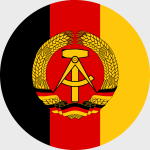Hobby Master HA0197 East German Mikoyan-Gurevich MiG-21MF "Fishbed" Fighter - "Red 511", Jagdfliegergeschwader 1 "Fritz Schmenkel", East Germany (1:72 Scale)
"Whether you like it or not, history is on our side. We will bury you!"
- First Secretary of the Communist Party of the Soviet Union Nikita Kruschev commenting on Capitalism
 The MiG-21 saw frequent action in the Vietnam War and was one of the most advanced aircraft at the time. However, many North Vietnamese aces preferred flying the MiG-17, due to the high wing loading on the MiG-21's. With high wing loading, the MiG-21 was not as agile or manueverable as the MiG-17. Employing a delta wing configuration, it was the first successful Soviet aircraft combining fighter and interceptor in a single aircraft. It was a lightweight fighter, achieving Mach 2 speed using a relatively low-powered afterburning turbojet, and is thus comparable to the American F-104 Starfighter and French Dassault Mirage III.
The MiG-21 saw frequent action in the Vietnam War and was one of the most advanced aircraft at the time. However, many North Vietnamese aces preferred flying the MiG-17, due to the high wing loading on the MiG-21's. With high wing loading, the MiG-21 was not as agile or manueverable as the MiG-17. Employing a delta wing configuration, it was the first successful Soviet aircraft combining fighter and interceptor in a single aircraft. It was a lightweight fighter, achieving Mach 2 speed using a relatively low-powered afterburning turbojet, and is thus comparable to the American F-104 Starfighter and French Dassault Mirage III.
It was also used extensively in the Middle East conflicts of the 1960s and 1970s, by the air forces of Egypt, Syria and Iraq against Israel. The plane was outclassed by the more modern F-15 Eagle (designed primarily to combat the Soviet MiG-25 "Foxbat"), which was acquired by Israel in the 1970s. The Indian Air Force has been one of the largest users of this plane after it was used in the 1971 war with good results. The war also witnessed the first supersonic air combat in the subcontinent when a MiG-21 shot down a F-104 Starfighter. It was also used as late as 1999 in the Kargil War with mixed results, and employed during the early stages of the Soviet invasion of Afghanistan, but was soon outclassed by the newer MiG-23 and MiG-27.
Due to the lack of available information, early details of the MiG-21 were often confused with those of the similar Sukhoi fighters also under development. Jane's All the World's Aircraft 1960-1961 describes the "Fishbed" as a Sukhoi design, and uses an illustration of the Su-9 "Fishpot." MiG-21SMT. A development of the MiG-21SM, the MiG-21SMT featured increased fuel capacity. This variant is easily spotted thanks to its larger spine. The designation is derived from S = Sapfir (referring to the Sapfir-21/RP-22 radar). M = Modernizirovannyy ("Modernised") T = Toplivo ("Fuel," referring to increased fuel capacity)
This particular 1:72 scale replica of an East German MiG-21MF fighter that was attached to Jagdfliegergeschwader 1 "Fritz Schmenkel".
Sold Out!
Dimensions:
Wingspan: 3-3/4-inches
Length: 8-inches
Release Date: January 2020
Historical Account: "Jagdfliegergeschwader 1" - In the period between August 16th and September 25th, 1952, the first (hunting) aviation regiment of the People's Police Air was set up with the KVP service 600/1. Although the squadron was placed on the former air force field airfield in Bautzen, but already relocated on September 26th on the airfield Cottbus-North. As decentralization airfield served the airfield Alteno. Several structural changes and renaming of the Aeroclub Cottbus (1st Aeroclub) belonging squadron followed up to the takeover in the NVA on July 1st, 1956. From September 1952 to October 1953, a troop unit of the Soviet Army was stationed on the site, which was to provide assistance in flight training and in dealing with technology. In October 1952, Soviet flight instructors began practical training at Yakovlev Yak-18. At the beginning of May 1953, the theoretical training for the MiG-15UTI began, which was aborted due to the events of June 17th, 1953. The further education now referred to the types Jak-18 and Jak-11. In 1955, the first own ten Jak-11 were taken over. It was not until 1956/1957 training at the MiG-15 continued. In 1957, the squadron took the first ten MiG -17F in the stock. From 1959 began the 3rd fighter squadron with the training of Il-28 pilots for target display flights. 1961 was renamed fighter squadron 1. At the end of 1966, the squadron was fully equipped with the MiG-21.
On October 7th, 1967, the squadron received the honorary title Fritz Schmenkel.


